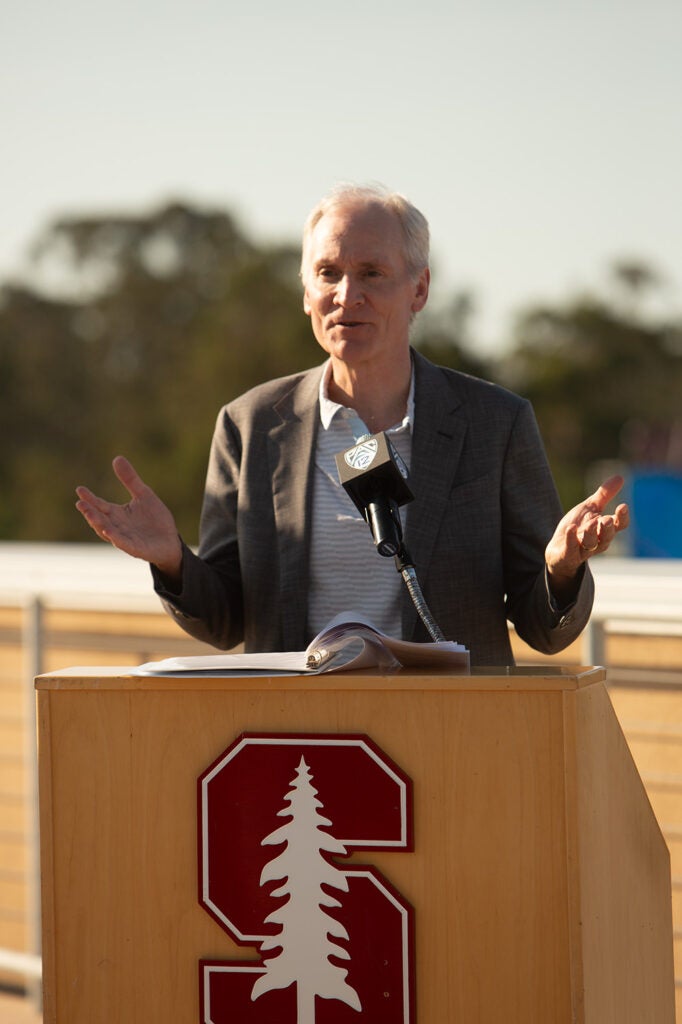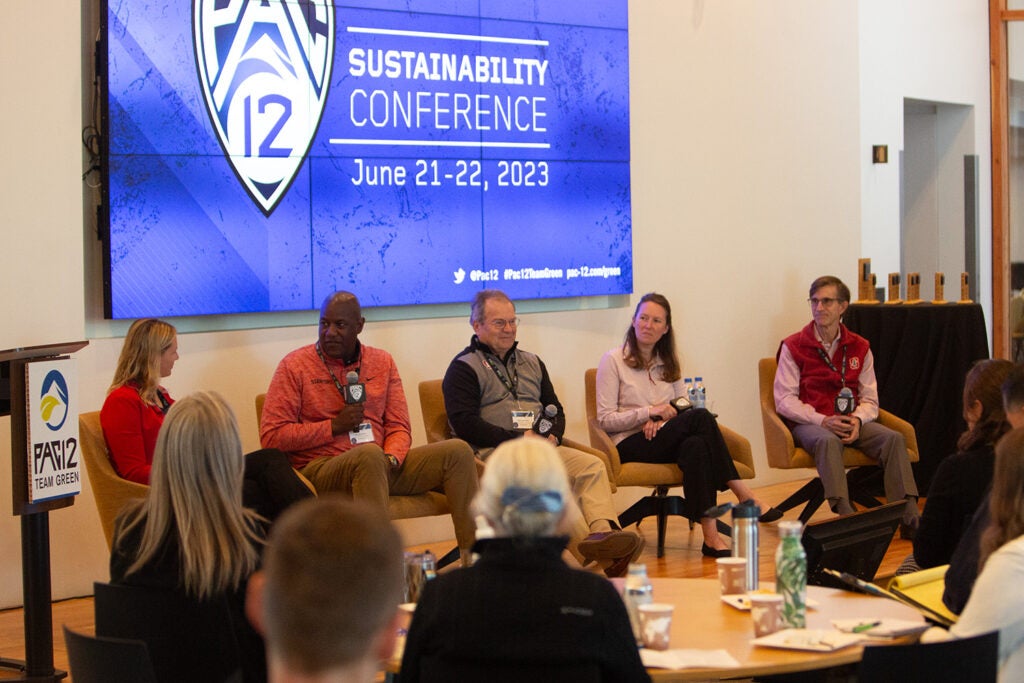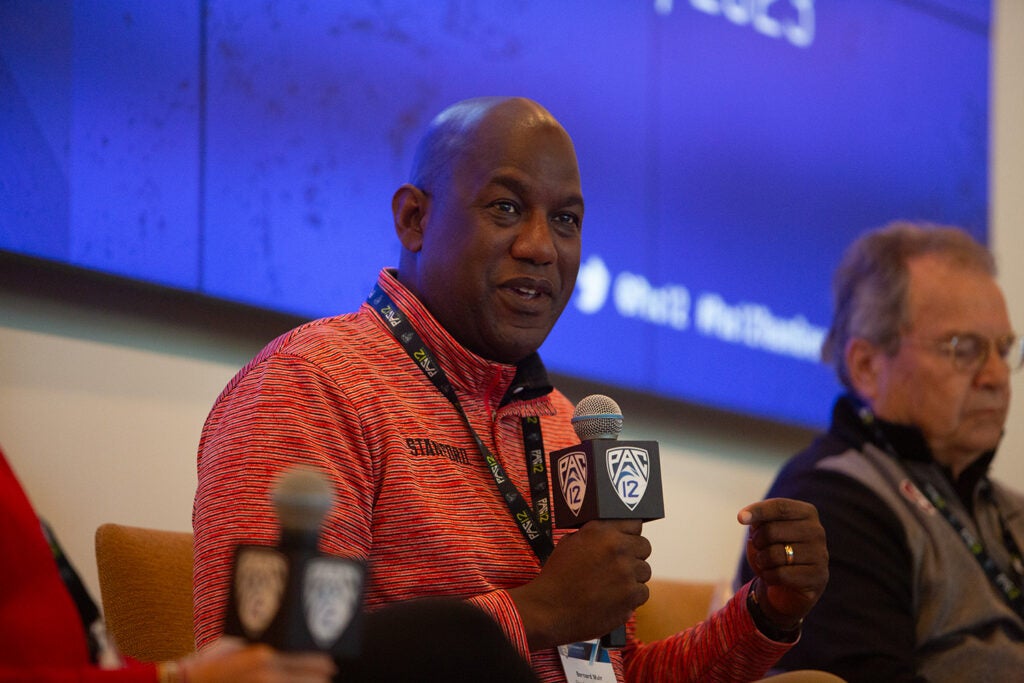Stanford hosts Pac-12 Sustainability Conference
The annual event, which made its first appearance at Stanford this year, convened Pac-12 universities to discuss sustainability efforts on college campuses and athletic departments.
Stanford hosted the Pac-12 Sustainability Conference Wednesday, June 21, and Thursday, June 22. Now in its seventh year, the event convened representatives from all 12 universities to discuss elevating approaches and enhancing sustainability efforts within collegiate athletics departments, designing new initiatives, and sharing best practices for transforming college sports into a platform for environmental progress.

Stanford President Marc Tessier-Lavigne delivers the keynote address at the Pac-12 Sustainability Conference. (Image credit: Josie Williamson)
The conference kicked off Wednesday afternoon with tours of Stanford’s Central Energy Facility, Recycling Center, and The Barn. In the evening, conference goers attended a welcome reception at Stanford Stadium where President Marc Tessier-Lavigne delivered the keynote address.
“Together, we have the opportunity to promote a culture and mindset of sustainability, here in the Pac-12, and beyond,” Tessier-Lavigne said at the event.
He shared some of the sustainability work happening across Stanford, including the recent opening of the Doerr School of Sustainability. With regard to athletics, he noted the ability of collegiate sports to bring fans and campus communities together and provide a platform for student-athletes to compete. But he said that sports can also generate considerable waste, emissions, and other impacts that harm the environment, and he encouraged Pac-12 schools to collaborate on finding solutions.
“Every time we host an event, whether it is a practice, a contest, a clinic, or a camp, we have the opportunity to demonstrate our universities’ commitment to sustainability,” he said.
The Pac-12 Sustainability Conference is one of the key components of Pac-12 Team Green, a platform that promotes sustainability among all 12 member universities. In addition to the sustainability conference, Team Green hosts the Pac-12 Zero Waste Competition and the Pac-12 Sustainability Working Group.
Collaborations and achievements
Thursday’s program took place at Denning House and included discussions on mitigating contamination, implementing sustainable practices at large sporting events, and the work that student-athletes are doing to implement sustainability measures.

From left: Moira Zbella, Bernard Muir, Jeff Koseff, Kristin Parineh, and Randy Livingston. (Image credit: Josie Williamson)
In the morning, Moira Zbella, Stanford’s Scope 3 Emissions program manager, moderated a panel discussion with Stanford leaders: Bernard Muir, athletics director; Kristin Parineh, associate director of climate action planning in the Office of Sustainability; Randy Livingston, CFO and vice president for business affairs; and Jeff Koseff, professor of engineering and founding director of the Stanford Woods Institute.
The discussion opened with the panelists sharing the collaborative sustainability accomplishments taking place across campus. They cited the Sustainable Energy System Innovations (SESI) program, which has transformed the university’s energy system from a fossil fuel-based system to 100% renewable, grid-sourced electricity. Livingston highlighted Stanford’s investment in the Central Energy Facility and a large heat exchanger as among the infrastructure improvements. And Koseff noted the 2008 construction of the Yang and Yamazaki Environment & Energy (Y2E2) building, which was designed to conserve natural resources and has sustainable features that are now common practice across campus.
Parineh said a new partnership between the Office of Sustainability and the Doerr School will include the new Sustainability Living Laboratory Fellowship Program, through which fellows will work on complex university-wide problems related to sustainability. She also cited the ways that Stanford is using its own campus as a living laboratory to test solutions, such as one former student’s idea for an ozone-based cleaning system to replace chemical-based products.
“It was just as effective if not more effective than traditional cleaners on the market,” she said. “And eight years later, the university has now invested over $3 million in transforming how we clean our campus.”
In Athletics, Muir reflected on the success of the zero-waste game day challenges, the installation of LED lighting at athletic venues, and the reduction of water usage on Stanford’s golf course. He also lauded the installation of shared waste stations in common areas in place of individual trash bins.
“We have 275 of these receptacles [in] 26 of our buildings – that’s pretty darn impressive,” he said.
Challenges and opportunities
The discussion turned to what the panelists saw as significant sustainability challenges they need to address. Parineh discussed the difficulty of tackling emission offsets as part of Stanford’s ambitious new climate action plan, and the many stakeholders that need to be involved in that process. Koseff said he continues to research water challenges and potential solutions, such as desalination, and noted that many believe the ocean to be an “infinite receptacle” to solve water problems.

Stanford Athletics Director Bernard Muir discusses sustainability efforts in college sports. (Image credit: Josie Williamson)
“It’s not,” he warned. “[Desalination] has massive environmental challenges associated with it that we tend to ignore.”
Muir said there are opportunities within Stanford Athletics to reduce water usage, such as limiting shower times in locker rooms and the watering of fields and courses. He also said that while there is a need to improve the efficiency of feeding student-athletes and fans, his department is making progress when it comes to educating them on how to sort their waste properly using the shared waste receptacles.
“There are so many opportunities here and I think we’re going to get better as time goes on,” Muir said.
Travel is a particularly complicated issue for collegiate athletics departments, and universities in general. Livingston noted that the challenge often lies in whether to prioritize time or environmental concerns.
“Air charter travel tends to result in greater emissions from taking commercial flights. But yet that’s a huge benefit to the wellness of our teams – the ability to not have to deal with [arriving] at the airport two hours early,” he said, adding that athletic conferences will have to take sustainability considerations into account when scheduling games.
Looking ahead
When asked where they see the state of sustainability at Stanford in ten years, panelists expressed optimism for the future. Koseff said he’s eager to see what innovative solutions are produced through the Doerr School’s Sustainability Accelerator, and Parineh said she’s hopeful the university will reach its zero-waste goal by 2030.
Muir added that Stanford Athletics will continue to learn from and collaborate with other units on campus, as well as universities, to improve its sustainability efforts.
“Ten years from now, I just think we’ll be running a much more efficient operation and one that, hopefully, our university community or conference community can be proud of,” he said.